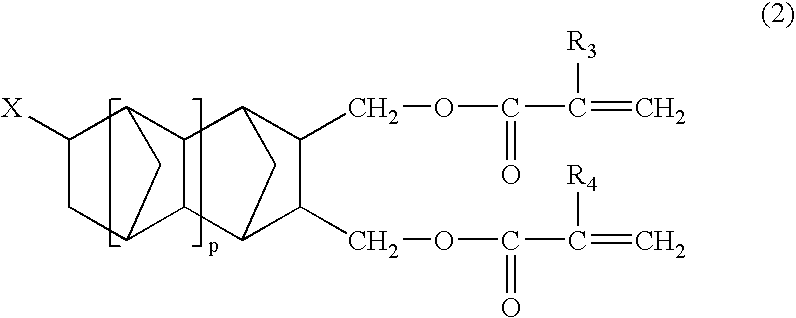Transparent composite composition
a composite composition and transparent technology, applied in the field of transparent composite compositions, can solve the problems of difficult application of composite compositions in such fields of use, difficulty in applying them, and impaired transparency of substrates
- Summary
- Abstract
- Description
- Claims
- Application Information
AI Technical Summary
Benefits of technology
Problems solved by technology
Method used
Image
Examples
example 1
[0067]A glass cloth made of E glass (thickness 50 μm, refractive index 1.560, Unitika Glass fiber E06B (#1080)) was deprived of organic matter by burning and then treated with acryloyloxypropyltriethoxysilane (acrylic silane compound). This glass cloth was impregnated with a resin composition (refractive index after crosslinking 1.560) composed of 58 parts by weight of dicyclopentadienyl diacrylate (formula 1) (M-203, product of Toagosei Co., Ltd.), 42 parts by weight of bis[4-(acryloyloxyethoxy)phenyl] sulfide (formula 3) (TO-2066, trial product of Toagosei, refractive index after crosslinking 1.606) and 0.5 part by weight of a photopolymerization initiator (1-hydroxycyclohexyl phenyl ketone, Irgacure 184, product of Ciba Specialty Chemicals), followed by degassing. The cloth obtained was subjected to lamination in the manner of resin / cloth / resin / cloth / resin, and the laminate was sandwiched between release agent-treated glass sheets and irradiated from both sides with UV rays at ab...
example 2
[0068]The same glass cloth as used in Example 1 was impregnated with a resin composition (refractive index after crosslinking 1.560) prepared from 53 parts by weight of norbornanedimethylol diacrylate (formula 2) (trial product of Toagosei, refractive index after crosslinking 1.520), 47 parts by weight of bis[4-(acryloyloxyethoxy)phenyl]sulfide (formula 3) (TO-2066, trial product of Toagosei, refractive index after crosslinking 1.606) and 0.5 part by weight of the photopolymerization initiator, followed by degassing. This glass cloth was subjected to lamination and the laminate subjected to UV light irradiation and heating treatment in the same manner as in Example 1 to give a sheet-like plastic substrate (thickness 0.2 mm). The glass filler content of the substrate was 30% by weight.
example 3
[0069]An E glass-based glass cloth (thickness 100 μm, refractive index 1.560, Unitika Glass fiber E10A (#2117)) deprived of organic matter by burning and treated with acryloyloxypropyltriethoxysilane (acrylic silane compound) was used as the glass cloth. This cloth was impregnated with the same resin composition as used in Example 1, followed by degassing. This glass cloth was sandwiched between release agent-treated glass sheets and irradiated from both sides with UV rays at about 500 mJ / cm2 for curing. The subsequent 3 hours of heating at about 100° C. and further 3 hours of heating at about 250° C. in a vacuum oven gave a sheet-like plastic substrate with a thickness of 0.1 mm. The glass filler content of the substrate was 50% by weight.
PUM
| Property | Measurement | Unit |
|---|---|---|
| thickness | aaaaa | aaaaa |
| glass transition temperature | aaaaa | aaaaa |
| refractive index | aaaaa | aaaaa |
Abstract
Description
Claims
Application Information
 Login to View More
Login to View More - R&D
- Intellectual Property
- Life Sciences
- Materials
- Tech Scout
- Unparalleled Data Quality
- Higher Quality Content
- 60% Fewer Hallucinations
Browse by: Latest US Patents, China's latest patents, Technical Efficacy Thesaurus, Application Domain, Technology Topic, Popular Technical Reports.
© 2025 PatSnap. All rights reserved.Legal|Privacy policy|Modern Slavery Act Transparency Statement|Sitemap|About US| Contact US: help@patsnap.com



